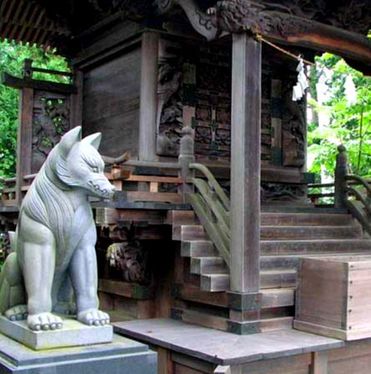The
wolf as god is above all worshipped under the name of
Ooguchi no Magami, 大口真神, the "
Large-Mouthed Pure God" (
magami まかみ/真神 [Kanji: 'true-god'] is also an archaic version of
ōkami, 'wolf')
; 大口, ōguchi means 'big mouth'). Once he was a very popular god and still today he is worshipped at some shrines, like Mitsumine, Ryogami Shrine and Mitake. There, the
komainu - the shrine guardians - have the form of a wolf (see images below).
An important
Wolf Deity Festival is the Ooguchi magami matsuri, 大口真神祭り. It takes place at the
Musashi Mitake jinja (
jinja=shrine) (武蔵御嶽神社) in
January (amazingly, in other cultures January is also associated with wolves, e.g. it was the Saxon
Wulf-monath, "wolf-month", and for North American Indians it was the 'wolf moon').
Ancient historic accounts from Japan report this mythical story how the wolf deity, a
white wolf (白狼, shirōkami), in times of need suddenly appeared to
Yamato Takeru, son of Emperor Keikko (around AD100). Takaru got lost on a road near Mitakesan (御嶽山) when a local demon shapeshifted into a white deer (白鹿) and obstructed the road. The
white wolf showed him the way and let his army on the right path, "and Takeru commanded the white wolf to stay in Mitakesan as a
true god, in order to slay any local demons."
Ancient myths that show people's veneration of wolves, even their divine status and role of wolves in creation myths, notably in Japan and North America.
ralphhaussler.weebly.com











